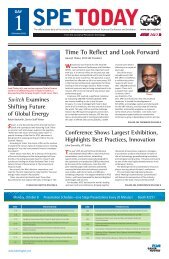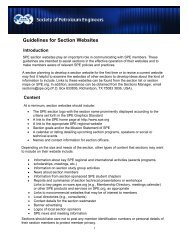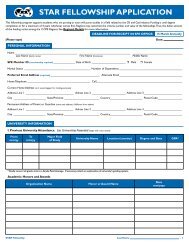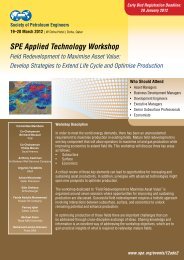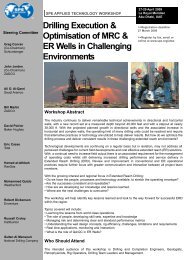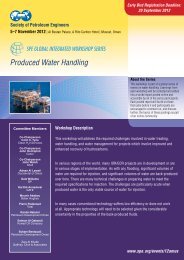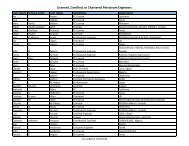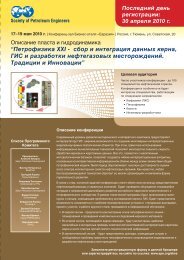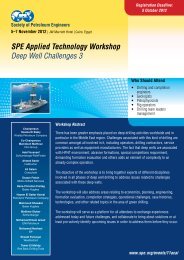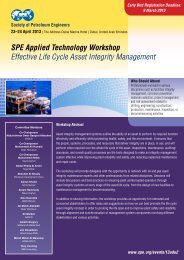Navier-Stokes Simulations of Surface Waves Generated by ...
Navier-Stokes Simulations of Surface Waves Generated by ...
Navier-Stokes Simulations of Surface Waves Generated by ...
You also want an ePaper? Increase the reach of your titles
YUMPU automatically turns print PDFs into web optimized ePapers that Google loves.
<strong>Navier</strong>-<strong>Stokes</strong> <strong>Simulations</strong><br />
<strong>of</strong> <strong>Surface</strong> <strong>Waves</strong> <strong>Generated</strong><br />
<strong>by</strong> Submarine Landslides:<br />
Effect <strong>of</strong> Slide Geometry<br />
and Turbulence<br />
D. Basu, S. Green, K. Das, R. Janetzke,<br />
J. Stamatakos<br />
Southwest Research Institute®, 6220 Culebra Road, San<br />
Antonio, TX 78238, USA<br />
2009 SPE Americas E&P Environmental & Safety<br />
Conference<br />
San Antonio, Texas, USA, 23–25 March 2009
Outline <strong>of</strong> Presentation<br />
•Background<br />
•Objectives<br />
•Technical approach<br />
•Results<br />
•Conclusions
Background<br />
Tsunami science has evolved significantly over<br />
the last few decades<br />
Important class <strong>of</strong> natural hazards<br />
Most commonly triggered <strong>by</strong> large-magnitude submarine earthquakes<br />
Active research in submarine landslide generated<br />
tsunamis<br />
Primarily occurs in world’s oceans<br />
Locally Intense and Potentially Destructive<br />
Large run-ups Damage coastlines<br />
Affects the <strong>of</strong>f-shore oil and gas industries<br />
Increased use <strong>of</strong> computational fluid dynamics<br />
(CFD) in tsunami modelling<br />
Full <strong>Navier</strong>-<strong>Stokes</strong> Equations<br />
Faster processors<br />
Better and faster numerical schemes : both spatial and temporal<br />
Advanced grid generation techniques to deal with complex geometries
Significance <strong>of</strong> Research<br />
•Efficient computational tool for prediction <strong>of</strong> landslide<br />
generated tsunami :<br />
•Oil and Gas Industry<br />
•Oil exploration region<br />
•An increasing proportion <strong>of</strong> the world’s oil and gas is now<br />
recovered from deepwater areas <strong>of</strong>fshore<br />
•Landslide-generated tsunamis can present significant<br />
risks to <strong>of</strong>fshore structures, such as oil and gas production<br />
platforms and remote terminal facilities<br />
•Turbulence, three-dimensionality in models, and landslide<br />
shape influence the generated tsunami waves
Landslides <strong>Generated</strong> tsunami<br />
Landslide
Existing Numerical Models<br />
Techniques Used Commonly for tsunami models :<br />
• Shallow water equations<br />
– Depth Averaging<br />
• Fully Non-Linear Potential Flow (FNPF) Model<br />
– Laplace’s Equation Boundary Integral Equation Boundary Element<br />
Method<br />
• Linear Theory <strong>Simulations</strong><br />
– Seafloor Uplift + Simple and Complex Slide<br />
– Green Function’s Approach<br />
• Water wave propagation Equation<br />
– 2-D Euler equations for mass and momentum (N-S equations with<br />
viscosity neglected)<br />
• EACH OF THESE METHODS HAVE BEEN USED IN EARTHQUAKE<br />
GENERATED TSUNAMI MODELLING<br />
Computational Method for simulating landslide generated tsunami<br />
waves : <strong>Navier</strong>-<strong>Stokes</strong> Equations with Free <strong>Surface</strong> Tracking<br />
Algorithm [Volume <strong>of</strong> Flow (VOF)] Method.
Objectives<br />
•Numerically simulate landslide generated<br />
tsunami wave : Compare simulated results<br />
with experimental data<br />
•Analyze the effect <strong>of</strong> slide geometry on the<br />
impulse wave characteristics and run-up<br />
•Assess the effect <strong>of</strong> turbulence model &<br />
computational grid on the predicted wave and<br />
run-up<br />
•Evaluate three-dimensionality <strong>of</strong> the flowfield
Technical Approach Solver<br />
•<strong>Navier</strong>-<strong>Stokes</strong> Volume <strong>of</strong> Flow (VOF) Approach with FLOW-<br />
3D<br />
•FLOW-3D : (Flow-Sciences Inc.)<br />
•Solves full <strong>Navier</strong>-<strong>Stokes</strong> equations<br />
•Employs volume <strong>of</strong> flow (VOF) method <strong>by</strong> FAVOR<br />
(Fractional area volume representation) technique<br />
•Number <strong>of</strong> turbulence models including RNG k-є models<br />
and LES models<br />
•Includes two fluid drift flux model as approximate Eulerian-<br />
Eulerian formulation
FLOW-3D<br />
Developer: Flow Sciences Inc<br />
Finite difference method<br />
OpenMP and MPI based Parallelization<br />
Multi-block structured grid<br />
Flow-3D®<br />
Different turbulence models<br />
Post-processor FLOWVU and FLOWPLOT<br />
Customization
Current <strong>Simulations</strong><br />
•Experimental data <strong>of</strong> Heinrich (1992)<br />
•Spatial Discretization : Implicit Scheme<br />
•Temporal Discretization : Semi-Implicit Scheme<br />
•FAVOR defines solid boundaries within the Eulerian grid<br />
•Two Turbulence Models used in the current analysis :<br />
–RNG Turbulence model (k-ε based) (Pure RANS model)<br />
–Detached Eddy Simulation (DES) based multiscale model<br />
–Both these models solve the equations for turbulent kinetic energy (k)<br />
and the turbulent kinetic energy dissipation rate (ε)<br />
•One case with laminar flow also simulated<br />
•Unsteady simulations<br />
•Landslide was represented <strong>by</strong> solid sliding wedges<br />
•Three slide geometries were used<br />
•Mass <strong>of</strong> the slide was kept constant
DES Multiscale Model<br />
•The DES modeling approach differs from the RANS modeling approach <strong>by</strong><br />
the eddy diffusivity closure through a switching function<br />
•The DES formulations allow the reduction <strong>of</strong> eddy viscosity in the regions <strong>of</strong><br />
interest, and fine scales are resolved.<br />
•A switching function is used to activate the reduction in eddy viscosity.<br />
•The DES model was incorporated in the FLOW-3D solver<br />
RANS<br />
model<br />
Multiscale DES<br />
model<br />
RANS<br />
Model<br />
Reduction in Eddy<br />
Diffusivity<br />
RANS<br />
Model<br />
Reduction in Eddy<br />
Diffusivity<br />
RANS<br />
Model<br />
Reduction in Eddy<br />
Diffusivity
Geometry & Parameters<br />
•The experiments were carried out in a<br />
channel 20-m long, 0.55 m wide, and 1.50 m<br />
deep in the Hydraulic National Laboratory,<br />
Chatou, France<br />
•The sliding wedge has a density <strong>of</strong> 2000<br />
kg/m 3 , and 45 o incline<br />
•The wedge velocity pr<strong>of</strong>ile is given <strong>by</strong><br />
V(t)=86 tanh(0.0175t), t ≤ 0.4s (1)<br />
V(t)=0.6 t > 0.4s<br />
(2)<br />
Wedge Velocity m/s<br />
0.7<br />
0.6<br />
0.5<br />
0.4<br />
0.3<br />
0.2<br />
0.1<br />
0<br />
0 0.5 1 1.5 2<br />
Time s
Geometry & Parameters (Contd.)<br />
•Three geometrical shapes for the slide were considered :<br />
•Triangular Geometry<br />
•Elliptical geometry<br />
•Rectangular Geometry<br />
•Computational grid used in the Analysis<br />
Baseline Grid : 120×40×40 cells in the x-, y-, and z-directions<br />
Coarser Grid : Resolution 1.414 times the baseline grid<br />
Finer Grid : Resolution 0.707 times the baseline grid<br />
•Effect <strong>of</strong> DES model constant C b on the analysis : Three<br />
different values <strong>of</strong> C b were used (C b = 0.1, 0.3, 0.5)
GENERAL FLOWFIELD<br />
(MOVIE-2D)
GENERAL FLOWFIELD<br />
(MOVIE-3D)
TIME DEPENDENT FLOW-FIELD<br />
Dynamic Viscosity Pa*sec<br />
Dynamic Viscosity Pa*sec<br />
1.20 m<br />
1.20 m<br />
4.10 m<br />
4.10 m<br />
T = 0.5 secs<br />
T = 1.0 secs<br />
Dynamic Viscosity Pa*sec<br />
1.20 m<br />
<strong>Simulations</strong> carried out<br />
using multiscale DES<br />
model and with C b<br />
= 0.3<br />
4.10 m<br />
T = 1.5 secs
Effect <strong>of</strong> Slide Geometry (RANS model)<br />
Rectangular Slide<br />
Elliptical Slide<br />
<strong>Simulations</strong> carried out<br />
using RNG k-ε RANS<br />
model<br />
Triangular Wedge Slide
Effect <strong>of</strong> Slide Geometry (DES Model)<br />
Dynamic Viscosity Pa*sec<br />
Dynamic Viscosity Pa*sec<br />
1.20 m<br />
1.20 m<br />
4.10 m<br />
Rectangular Slide<br />
4.10 m<br />
Elliptical Slide<br />
Dynamic Viscosity Pa*sec<br />
1.20 m<br />
<strong>Simulations</strong> carried out<br />
using multiscale DES<br />
model and with C b<br />
= 0.3<br />
4.10 m<br />
Triangular Wedge Slide
RANS & DES comparison<br />
Dynamic Viscosity Pa*sec<br />
1.20 m<br />
4.10 m<br />
DES Multiscale Model C b<br />
= 0.1<br />
DES Multiscale Model C b<br />
= 0.3<br />
DES Multiscale Model C b<br />
= 0.5<br />
RANS Turbulence Model
1.10<br />
Fluid <strong>Surface</strong> Height<br />
& Wave Run-up<br />
1.05<br />
Surfqace Height m<br />
1.00<br />
0.95<br />
0.90<br />
0.85<br />
0.80<br />
0.75<br />
0.70<br />
Time = 1 s after Block Release<br />
2-D Laminar<br />
2-D Experiment (Heinrich)<br />
3D Rect, Cb=0.3<br />
3D Ellipse, Cb=0.3<br />
3D, Wedge, Cb=0.1<br />
3D, Wedge, Cb=0.3<br />
3D, Wedge, Cb=0.3, Fine<br />
3D, Wedge, Cb=0.3, Coarse<br />
3D, Wedge, Cb=0.5<br />
0.0 1.0 2.0 3.0 4.0<br />
Position from 'Shoreline' m<br />
<strong>Surface</strong> Height (m)<br />
Wave Runup m<br />
0.10<br />
0.05<br />
0.00<br />
-0.05<br />
2D Laminar<br />
Wedge, MST, Cb=0.1<br />
-0.10<br />
Wedge, MST, Cb=0.3<br />
Wedge, MST, Cb=0.5<br />
-0.15<br />
Wedge, MST, Cb=0.3, Coarse<br />
Wedge, MST, Cb=0.3, Fine<br />
Wedge, RNG<br />
-0.20<br />
Rectangle, MST, Cb=0.3<br />
Ellipse, MST, Cb=0.3<br />
-0.25<br />
0.0 0.5 1.0 1.5 2.0<br />
Time after Block Release s<br />
Wave Runup (m)
Three-dimensionality<br />
<strong>of</strong> the flow-field<br />
Isosurface <strong>of</strong> Q=0.2<br />
Side Structures<br />
Front Edge Structure<br />
Ramp<br />
Wedge
Conclusions<br />
•Flow is strongly three-dimensional and turbulent<br />
•Slides with hydrodynamically efficient shapes produce less turbulence and<br />
bluff body effect<br />
•The flow turbulence is found to be localized<br />
•Flow turbulence do not greatly affect the far field effects such as wave height and<br />
runup<br />
•In the near field, however, turbulence appears to play a stronger role<br />
•Multiscale DES models result in less diffusive solution compared to RANS<br />
model. Diffusivity can be controlled <strong>by</strong> the parameter C b<br />
•Computational grids do not have any significant influence on the predicted<br />
wave runup or surface height.<br />
•CFD based computational tool can help provide inputs to assess risk from<br />
landslide-generated tsunamis for near shore as well as <strong>of</strong>fshore structures
Acknowledgements<br />
•Advisory Committee for Research at the<br />
Southwest Research Institute<br />
• Technical support staff from Flow-<br />
Sciences, Inc




